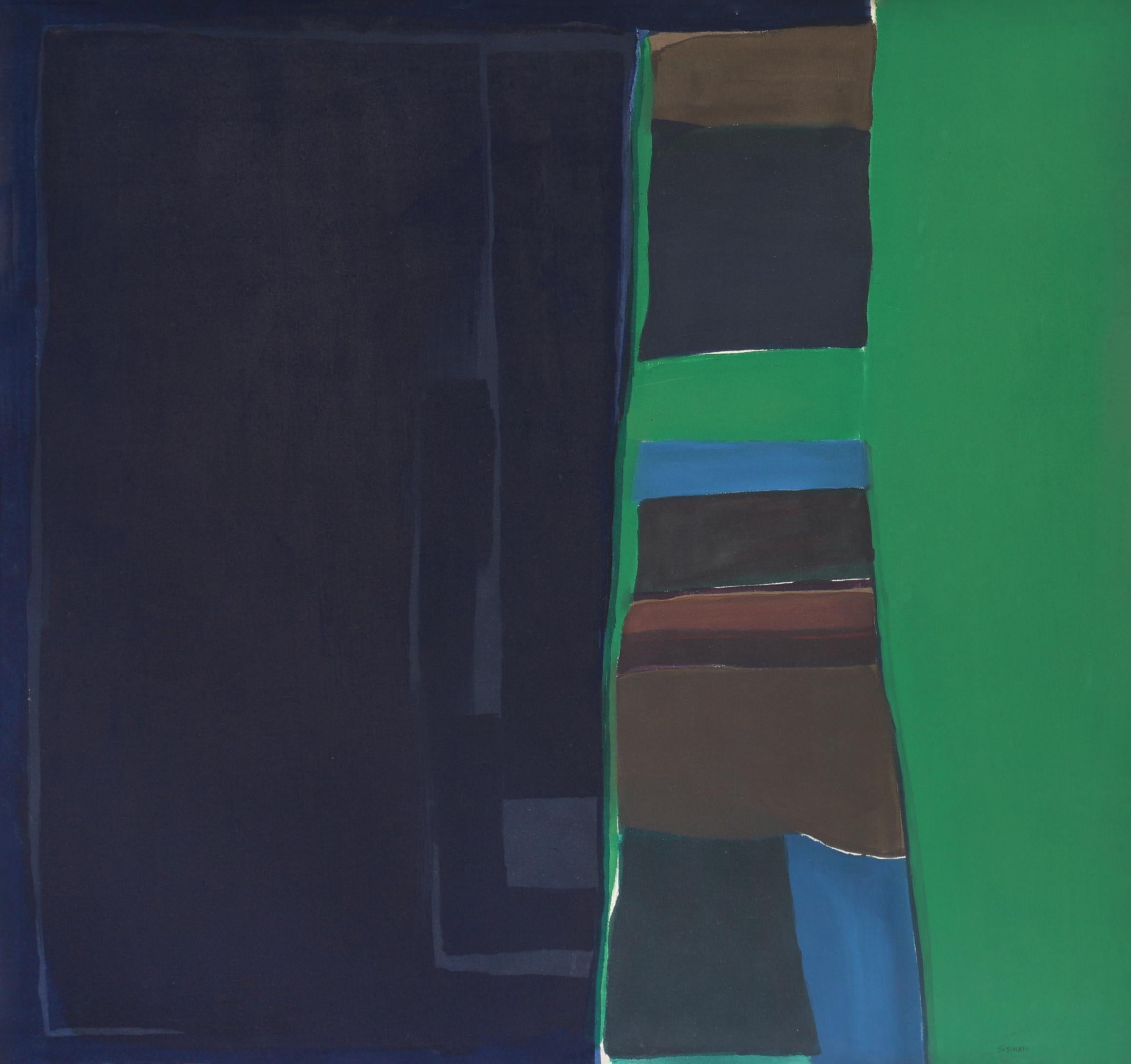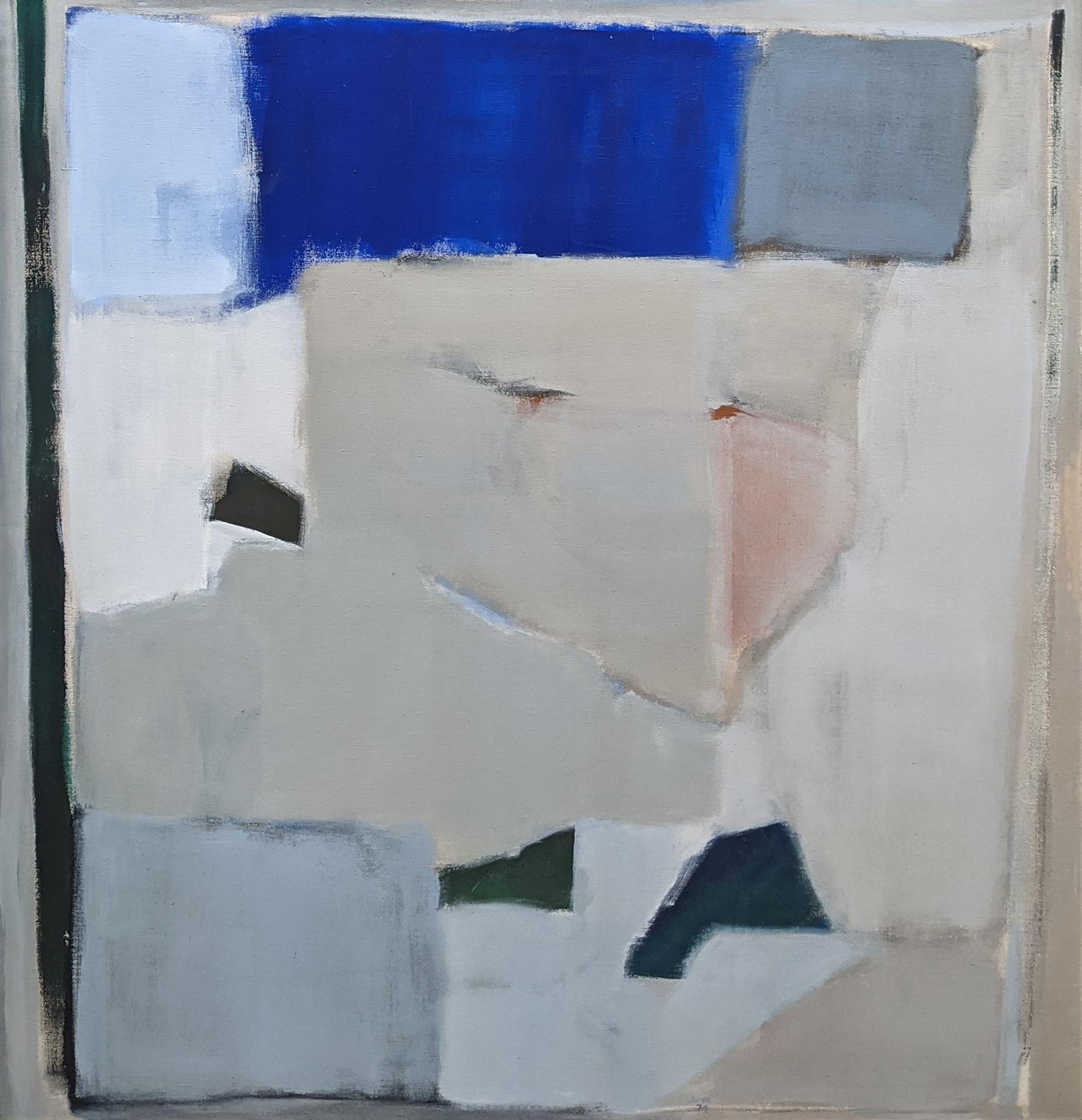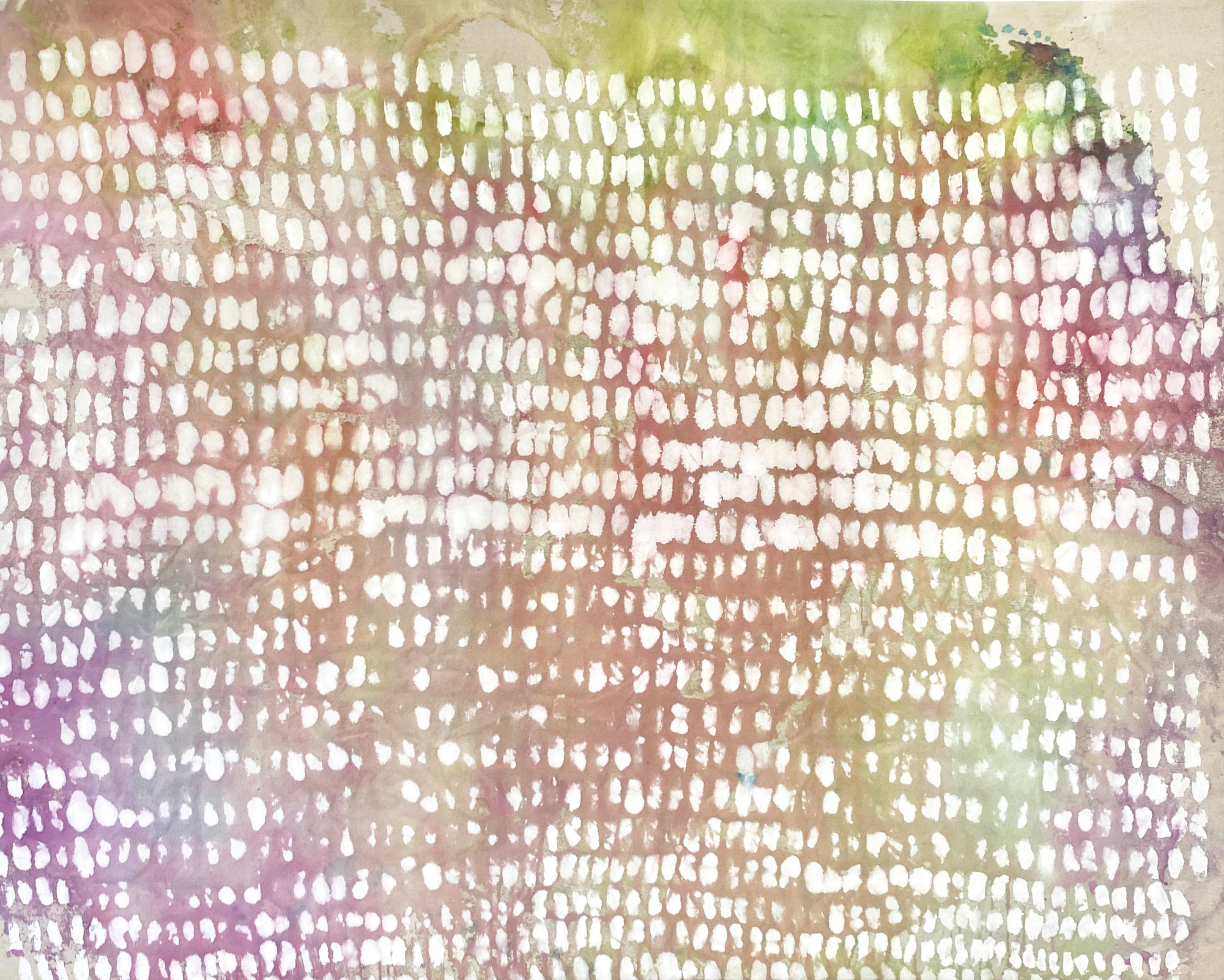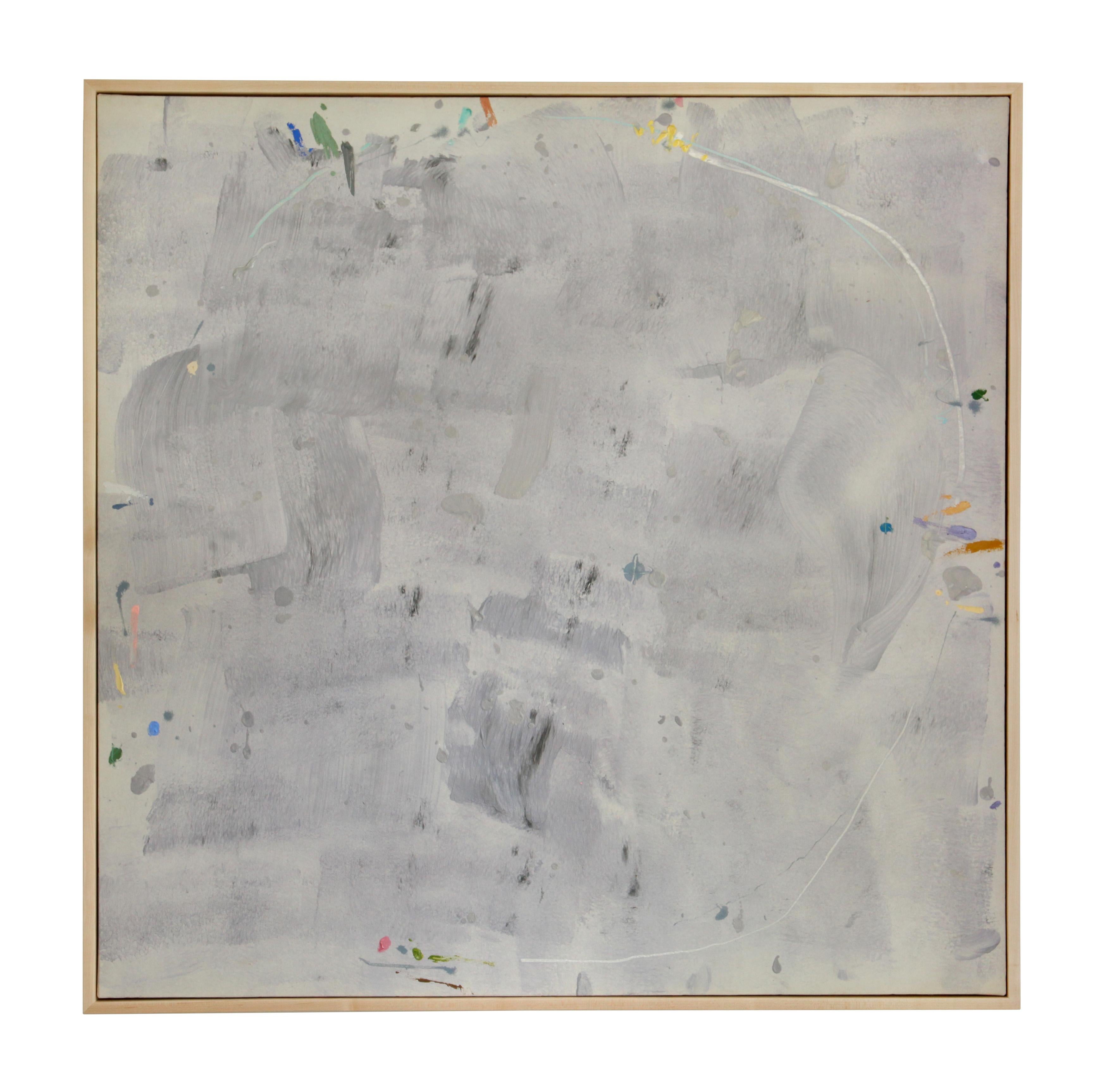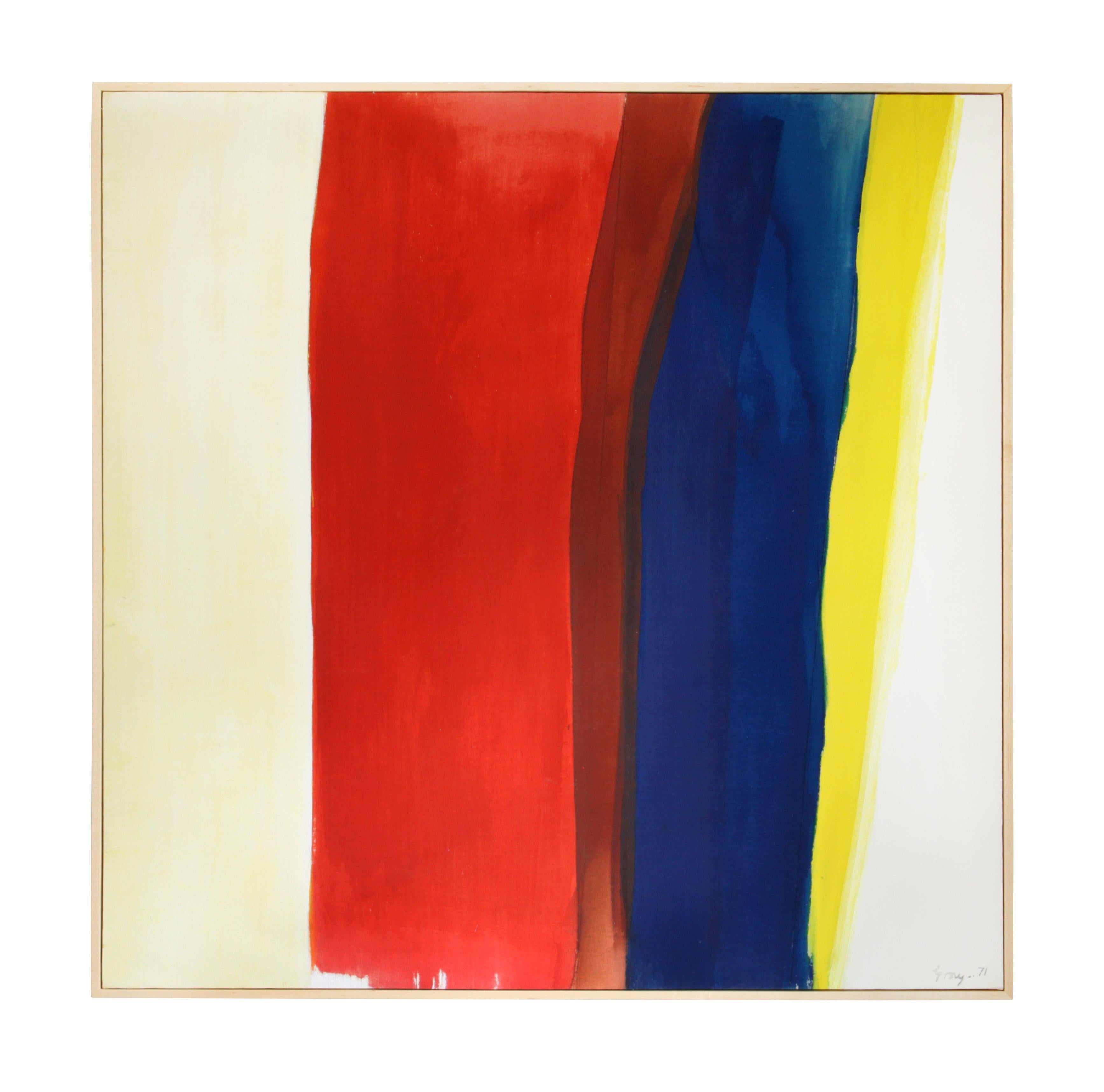Items Similar to "Nineteen" Thomas Downing, Purple Washington Color School Design, Shaped Canvas
Want more images or videos?
Request additional images or videos from the seller
1 of 8
Thomas Downing"Nineteen" Thomas Downing, Purple Washington Color School Design, Shaped Canvas1968
1968
About the Item
Thomas Victor Downing (1928 - 1985)
Nineteen, 1968
Acrylic on canvas
35 1/2 x 16 1/2 inches
Signed on the reverse
Provenance:
Estate of the artist
Henri Gallery, Washington, D.C.
Private Collection, Washington, D.C.
Thomas Downing was born in Suffolk, Virginia. In 1950, after graduating from Pratt Institute in New York City, he received a grant from the Virginia Museum of Fine Art to study in Europe. Upon returning from Europe, he settled in Washington, DC to teach at Catholic University. In 1954 Downing became a friend of Kenneth Noland, whose life drawing course he attended. From 1955 to 1956 Downing shared a studio with Howard Mehring, another artist who came to be identified with the Washington Color School. Downing had his first one-man show at the Washington Workshop Center for the Arts in 1959. That year, Downing, Mehring, and Betty Pajac founded Origio, a cooperative art gallery in Washington.
In 1959 Downing first began using the small dot in his work, a motif he explored fully into the 1970s. In the early works colorful dots determined the structure of the painting in their size, position, and repetition within a grid. Often there was a sense of concentration and expansion of the composition from the center to the edge of the canvas, achieving a visual impression of expanding open space. Looking for the fusion between the grid and color, Downing eliminated overlapping dots in 1962. The dots arranged in grids seem to project from the canvas surface, giving the impression the color floats unrestricted by the square format of his paintings.
Downing’s position in the Washington Color School came from his consistent approach to color. The canvas was the receptacle of color, on which Downing often worked in tonal modulations of a hue. Downing developed shaped canvases in 1966 as a structural solution to his deeper consideration of the “spatial definition” of color. After first working in a parallelogram shape, Downing next worked in chevron-shaped canvases that examined the illusionistic qualities of color. He exhibited these works in a solo exhibition at the Corcoran Gallery in 1966-1967 and later at the Allan Stone Gallery in New York in 1967. Downing’s second series of shaped canvases titled Folds were created in 1968. In the Fold series he discovered a new effect of relief and spatial depth within a flat work that could be enhanced by color. The projections and folding in the Fold paintings suggest the paintings exist in a world without gravity.
Downing exhibited in a group show at Jefferson Place Gallery in 1960 and had his first solo exhibition there in the spring of 1961. Downing had solo exhibitions in New York at Allan Stone Gallery in 1962, 1967, and 1968. He also had solo exhibition in New York at Stable Gallery in September 1963 and January 1965. In the early 1970s Downing had regular solo exhibitions at the Pyramid Galleries in DC.
In the 1960s Downing was included in important museum exhibitions, including: Post Painterly Abstraction at Los Angeles County Museum of Art, 1964 (Clement Greenberg curated and included three of Downing’s dial paintings); The Responsive Eye at the Museum of Modern Art, 1965; Colorists, 1950-1965 at the San Francisco Museum of Art, 1965; Systemic Painting at the Solomon R. Guggenheim Museum, New York, 1966; and Color Field Painting at the Philadelphia Museum of Art in 1970. Thomas Downing: Recent Paintings was held at the Corcoran Gallery of Art in December 1966 - January 1967. A solo exhibition of his paintings from 1962 to 1968 was held at the La Jolla Museum of Art then travelled to the Phoenix Art Museum in 1968. Downing had a solo exhibition at the Phillips Collection in 1985.
Downing taught at the Corcoran School of Art and Design, Washington, DC from 1965 to 1968. There he was influential for the next generation of DC color artists including Sam Gilliam. He moved to New York in 1970 and taught at the School of Visual Arts. He then accepted a position at the University of Houston, Texas in 1975. Around 1976, Downing moved to Provincetown where he continued to paint until his death in 1985.
In 2007 Thomas Downing was included in Optic Nerve: Perceptual Art in the 1960s at the Columbus Museum of Art, Ohio and Lyrical Color: Morris Louis, Gene Davis, Kenneth Noland and the Washington Color School at the Phillips Collection, Washington, DC. In 2015, Downing’s painting Five, 1967 was featured in the Whitney Museum’s inaugural exhibition in their new space America is Hard to See.
Downing’s works are in many collections including the Whitney Museum of American Art, New York, NY; the Smithsonian American Art Museum, Washington, DC; the Hirshhorn Museum and Sculpture Garden, Washington, DC; the Phillips Collection, Washington, DC; the Harvard Art Museums, Cambridge, MA; the North Carolina Museum of Art, Raleigh, NC; the Norton Simon Museum, Pasadena, CA; the Oklahoma City Museum of Art, OK; and the Virginia Museum of Fine Arts, Richmond, VA.
- Creator:Thomas Downing (1928-1985, American)
- Creation Year:1968
- Dimensions:Height: 35.5 in (90.17 cm)Width: 16.5 in (41.91 cm)
- Medium:
- Movement & Style:
- Period:
- Condition:
- Gallery Location:New York, NY
- Reference Number:1stDibs: LU184129923592
About the Seller
5.0
Platinum Seller
These expertly vetted sellers are 1stDibs' most experienced sellers and are rated highest by our customers.
Established in 2021
1stDibs seller since 2022
59 sales on 1stDibs
Typical response time: 1 hour
- ShippingRetrieving quote...Ships From: Larchmont, NY
- Return PolicyA return for this item may be initiated within 3 days of delivery.
More From This SellerView All
- "Eleven Thirteen, (Dancing Line Series), " Elliott Thompson, Color Field AbstractLocated in New York, NYElliott Thompson Eleven Thirteen, (Dancing Line Series), 1972 Signed, Elliott Thompson, dated, 2/72, and inscribed, Eleven Thirteen, on verso and agai...Category
1970s Color-Field Abstract Paintings
MaterialsCanvas, Tape, Acrylic
- “Untitled.” Gabriele Evertz, Geometric Color Field, Bright RainbowLocated in New York, NYGabriele Evertz Untitled, 1993 Acrylic on canvas 48 x 48 inches Provenance: The artist Private Collection, Long island (acquired from the above) G...Category
1990s Color-Field Abstract Paintings
MaterialsCanvas, Acrylic
- "Burnt Orange Seams" Gerome Kamrowski, Color Field, Abstract ExpressionismBy Gerome KamrowskiLocated in New York, NYGerome Kamrowski Burnt Orange Seams, 1979 Acrylic on canvas 30 x 24 inches Gerome Kamrowski was born in Warren, Minnesota, on January 19, 1914. In 1932 he enrolled in the Saint Paul...Category
1970s Color-Field Abstract Paintings
MaterialsFoam, Mixed Media, Acrylic, Board
- "Night Road" Gerome Kamrowski, Abstract Expressionism Surrealism, Purple ImpastoBy Gerome KamrowskiLocated in New York, NYGerome Kamrowski (1914 - 2004) Night Road, 1966 Acrylic on canvas 58 1/4 x 96 1/4 inches Signed and dated Provenance: The Artist The Kamrowski Estate (by family descent in 2004) Exhibited: The Detroit Institute of Arts, Detroit, Michigan, 56th Exhibition for Michigan Artists, November 18 - December 31, 1966, no. 32, illustrated (Night Road was the winner of the "Phyllis King Weiner Memorial Prize" at this exhibition). Ann Arbor, University of Michigan Museum of Art, Gerome Kamrowski: A Retrospective Exhibition, August 30 - October 16, 1983, no. 70, illustrated. Tarpon Springs, Florida, Leepa-Rattner Museum of Art, St. Petersburg College, Gerome Kamrowski: An American Surrealist, September 8 - October 27, 2002, no. 23. Chelsea, Michigan, River Gallery, Gerome Kamrowski: 1914-2004, A Memorial Retrospective, October 30 - December 5, 2004. Gerome Kamrowski was born in Warren, Minnesota, on January 19, 1914. In 1932 he enrolled in the Saint Paul School of Art (now Minnesota Museum of American Art - MMAA), where he studied with Leroy Turner, and Cameron Booth. Both Turner and Booth had been students of Hans Hofmann, and were also associated with the Abstraction-Création group in Paris. It was from these peers that Kamrowski was introduced to a "kind of expressionist cubism." In 1933 Kamrowski was awarded a scholarship to the Art Students League, where he would study in New York under Hans Hofmann. Unfortunately, immigration problems had prevented Hofmann from assuming his post. Nevertheless, Kamrowski decided to remain in New York for a short time, to attend classes taught by George Grosz. After a few weeks, he returned to St. Paul, and found a position in the mural painting division of the Minnesota FAP/WPA (Works Progress Administration). In 1936 he contributed “Synthetic Cubist Style” frescoes in the Northrup Auditorium of the University of Minnesota. In 1937 Kamrowski went to Chicago to study under László Moholy-Nagy and Alexander Archipenko at the New Bauhaus (now Illinois Institute of Technology's Institute of Design). There he was exposed to new and interesting ideas regarding the role of nature in art and the "geometric basis of natural form". In 1938 Kamrowski received a Guggenheim fellowship to attend Hans Hofmann's summer school in Provincetown, Massachusetts. He then relocated to New York where he met William Baziotes. Together they shared a fascination in Surrealist automatic writing, and both artists explored its possibilities in their paintings. Kamrowski was particularly drawn to Surrealism's fundamental appeal of intuition over intellect. He was interested seeking a process that "binds all things together...a kind of cosmic rhythm". Throughout the late 1930s and early 1940s while living in New York, Kamrowski became an integral part of the emerging surrealists. In 1942, the artist Roberto Matta attempted to form a group of artists to investigate new applications for Surrealist methods. He invited Kamrowski, along with William Baziotes, Jackson Pollock, Peter Busa...Category
1960s Abstract Expressionist Abstract Paintings
MaterialsCanvas, Acrylic
- "Untitled, " Sherron Francis, Female Abstract Expressionism, White ImpastoBy Sherron FrancisLocated in New York, NYSHERRON FRANCIS (AMERICAN, B. 1940) Untitled, 1977 Acrylic on canvas 33 x 27 1/2 inches Signed, titled and dated on the reverse A reappraisal is long ...Category
1970s Abstract Expressionist Abstract Paintings
MaterialsCanvas, Acrylic
- "Cepheus B, " Yeffe Kimball, Female Native American Abstract ExpressionistLocated in New York, NYYeffe Kimball (c. 1905 - 1978) Cepheus B, 1963 Signed, titled, and dated on the reverse Acrylic on canvas 34 x 40 inches Provenance: Private Collection, New York Estate of the above, 2022 Born in Mountain Park, Oklahoma, in 1914, Effie Y. Goodman subsequently spent her early years on her grandfather’s farm in Missouri. She attended college in Ada and the University of Oklahoma in Norman from 1931-1935. After college, she went to New York where she worked under distinguished artists such as George Bridgman and John Corbin at The Art Students League in New York in the early 1940s. She adopted the name Yeffe Kimball, adapting her first husband's surname of Campbell to form Kimball, and never returned to her small-town roots. She became a world traveler and student, studying intermittently with Fernand Léger in Paris from 1940-1941. In 1948, she married Harvey L. Stalin, an atomic scientist. Her art was influenced by Stalin’s work and she entered a new era, focusing on burning planets, atmospheric gases, and flashing comets. Her work was also inspired by American Indian spiritual...Category
1960s Abstract Expressionist Abstract Paintings
MaterialsCanvas, Acrylic
You May Also Like
- Blue and Green AbstractBy Claudia SisemoreLocated in Salt Lake City, UT"Blue and Green Abstract" by Claudia Sisemore, acylic on canvas, 43.5 x 46 inches, $4,800. "I have a vague idea of what I am going to paint. I...Category
1970s Color-Field Abstract Paintings
MaterialsCanvas, Acrylic
- Untitled, 1974By Claudia SisemoreLocated in Salt Lake City, UT"Untitled, 1974" by Claudia Sisemore, acylic on canvas, 58 x 56 inches, $7,200. Unframed. "I have a vague idea of what I am going to paint. I read that many artists are inspired by an idea before they begin their work and plan their approach and process based on that idea or muse. Others become inspired after they have begun working and watching colors, shapes and designs form. I basically belong the second group. Usually, after painting begins in a loose, free manner, I become excited by certain colors and patterns and continue from there." -Claudia Sisemore -- Caudia Sisemore says she was teaching English when artist David Chaplin (an equally popular and influential teacher) was at Weber and initially got her into landscape painting. “Then he took me to a show at the Art Barn and Lee [Deffebach] was showing there [with Don Olsen...Category
1970s Color-Field Abstract Paintings
MaterialsCanvas, Acrylic
- Untitled, 1975By Claudia SisemoreLocated in Salt Lake City, UT"Untitled, 1975" by Claudia Sisemore, acylic on canvas, 41.5 x 50 inches, $4,800. "I have a vague idea of what I am going to paint. I read that many artists are inspired by an idea before they begin their work and plan their approach and process based on that idea or muse. Others become inspired after they have begun working and watching colors, shapes and designs form. I basically belong the second group. Usually, after painting begins in a loose, free manner, I become excited by certain colors and patterns and continue from there." -Claudia Sisemore -- Caudia Sisemore says she was teaching English when artist David Chaplin (an equally popular and influential teacher) was at Weber and initially got her into landscape painting. “Then he took me to a show at the Art Barn and Lee [Deffebach] was showing there [with Don Olsen...Category
1970s Color-Field Abstract Paintings
MaterialsCanvas, Acrylic
- ephemeral vignette #03 - Colorful abstract stain painting, acrylic on raw canvasLocated in Philadelphia, PA'ephemeral vignette #03' acrylic painting by contemporary artist Elisa Niva, Acrylic on raw canvas 36 inches x 44 inches. Ephemeral is a large fluid pain...Category
2010s Color-Field Abstract Paintings
MaterialsCotton Canvas, Acrylic
- Spanish GhostBy Kikuo SaitoLocated in Austin, TXAcrylic on canvas. Signed, dated, and titled verso. 52.25 x 52.75 in. 54 x 54.25 in. (framed) Custom framed in a maple hardwood floater. Provenance Salander O’Reilly Galleries, Ne...Category
1980s Color-Field Abstract Paintings
MaterialsCanvas, Acrylic
- Captain CookBy Cleve GrayLocated in Austin, TXAcrylic on canvas. Signed and dated lower right, titled verso. 69 x 68.25 in. 70.5 x 70 in. (framed) Custom framed in a solid maple floater. Provenance Private Collection, Hilton ...Category
1970s Color-Field Abstract Paintings
MaterialsCanvas, Acrylic
